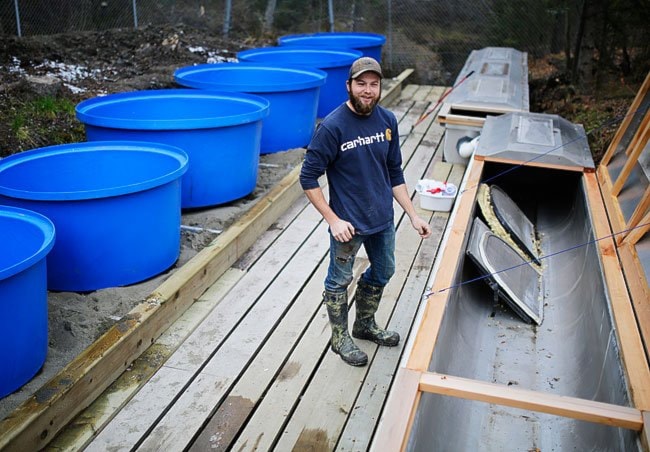A tiny fish hatchery just outside Porter Creek is making big strides to help the Yukon’s struggling chinook salmon population.
If you’re not looking for it, the McIntyre Creek hatchery is easy to miss. Down a steep hill just off the side of the road, it looks more like cabins from a forgotten summer camp than an advanced scientific project trying to rescue a species.
Wooden platforms weave between incubators, troughs, tanks and pipes directing the vital water that flows from underneath.
McIntyre Creek is a great place for raising baby fish. In the summer it peaks at six degrees Celsius. In the winter, because the current is always moving, it never freezes and bottoms out at about four degrees. No heating required.
“It’s a really unique site: to have a ground water site like that, that never freezes, the temperature never changes, the volume never changes,” said Darrell Otto, an instructor with the Yukon College’s renewable resource management program.
“That it’s located within the city of Whitehorse, sites like that are very rare.”
Tens of thousands of fry, juvenile fish about six centimetres long, have been tagged and released into Fox Creek as part of a joint project with the Ta’an Kwach’an Council.
Last season, 23,500 fry hatched at the site went into the creek, a tributary of Lake Laberge. It was 17,000 the year before that.
But that’s a drop in the bucket compared to what could be coming.
Over the past two years the tiny hatchery has expanded, thanks to more than $60,000 in contributions from the college, Yukon’s Community Development Fund, the Pacific Salmon Commission, the Pacific Salmon Foundation and the Ta’an Kwach’an Council.
Eight round tubs have been added to two of the older steel variety for holding the fry. Two more will be added next year. Thirty-two incubation trays for the eggs have already grown to 48.
Otto estimates the hatchery could have capacity for 200,000 fish.
The man in charge of construction is ideally suited for the job. Jake Montgomery is a sheet metal worker by trade who also worked as a carpenter for years.
In the meantime, he finished Yukon College’s renewable resource program this spring and stayed to do the Northern Environmental and Conservation Science program run with the University of Alberta.
“I enjoy doing it, especially working here. I’d love to just run a fish hatchery.”
Last year new decks and railings went up. Most of the big changes are more recent.
There are now lights so that the students who check on the fish - even in the dead of winter - can see what they’re doing. They used to wear headlamps.
Walls are going up on the incubation building instead of the tarps that used to be there. And they’ve replaced all the plumbing and reinforced the dam.
Montgomery’s motivation is simple: “Right now, to help with the chinook stock.”
It’s a stock that has been in trouble for decades.
But with work like what is being done at the hatchery, combined with agreements between Canadian and American governments, the numbers have started to improve.
In 2014, the pre-season estimates suggested that the total run size would be between 60,000 and 120,000 fish. In 1982, the salmon run peaked at around 300,000 fish.
The improved hatchery has come a long way from how it started. In 1989 it was run by the federal Department of Fisheries and Oceans, which is still involved.
“At first they just stuck some boxes in the water. Like little perforated plastic boxes and reared the eggs out in that,” Otto said.
In 1996 it was run by inmates at the Whitehorse Correctional Centre and in 2002 taken over by the Yukon Research Centre.
Otto and the college took over in 2013.
“It just fits so well with the college’s agenda. Education obviously is big too. We use it for lab sessions and most of the employees are students,” he said.
Employees come every day when there are fish, cleaning and monitoring the waters and tracking their progress.
“It gives them experience in a hatchery that they can put on their resume when they graduate.”
The Ta’an Kwach’an Council Fox Creek partnership has been running since 2009.
According to elders, fish used to be plentiful in the creek. But they stopped coming back.
In 2013 the first few salmon returned.
Nine came back to spawning grounds this summer.
“That was big. That was big,” Otto said. “Because it means that project is going to continue.”
Once enough spawners return, eggs can be collected directly from the creek and “really step things up,” he said.
Until that happens, eggs are coming from Yukon Energy’s Whitehorse Rapids Fish Hatchery.
About 50,000 are scheduled to arrive Nov. 2. They’ll spend the winter at the McIntyre Creek site and be released around June.
The build-up to 200,000 fry is expected to take three years, Otto said.
Now that all the infrastructure is in place he hopes to connect with other First Nations interested in their own restoration projects.
With 12 separate tubs, eggs could be brought in from all over the territory without the fear of accidental cross-breeding.
“Because it’s a big thing to start mixing up genetics, that’s a major concern. If we’re bringing in fish from Mayo or Teslin, you don’t want to mix them up,” he said.
New projects could be funded with grants, or the hatchery could use a model found elsewhere and charge a few cents for every fish that’s hatched. It would only be enough to recover all the costs, he said.
More space also means more opportunities for research.
“It provides a service to the larger community that we in the past haven’t been using to its full capacity, and that’s very much what we would like to do.”
Contact Ashley Joannou at
ashleyj@yukon-news.com
